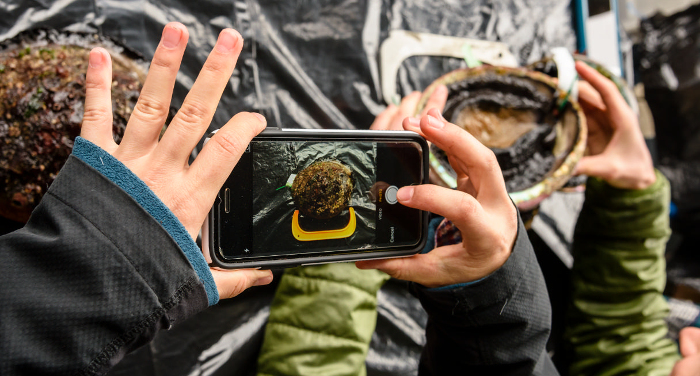Wild capture fisheries supply food and jobs for hundreds of millions of people across the globe. Yet an estimated 68% of global fisheries are overfished, contributing to food insecurity, economic impacts, and an erosion of biodiversity. Ocean health and sustainable fisheries both depend on effective fisheries management.
Effective management of fisheries requires three fundamental elements: data collection, stock assessment and implementation of effective rules and regulations. Innovative approaches and technological solutions such as data-limited assessments, electronic monitoring, and co-management can address these needs, but have yet to be scaled broadly.
California fisheries supply more than 250 species of local seafood. The Conservancy aims to ensure these fisheries are managed sustainably with cutting edge approaches and technology that improve the environmental and economic performance of fisheries, protect habitats and vulnerable species, reduce bycatch, and serve as a model for global fisheries management reform.

William J. Harford, Ricardo Amoroso, Richard J. Bell, Matias Caillaux, Jason Marc Cope, Dawn Dougherty, Natalie Anne Dowling, Frank Hurd, Serena Lomonico, Josh Nowlis, Dan Ovando, Ana M. Parma, Jeremy D. Prince, Jono R. Wilson
Overfishing threatens the health of ocean ecosystems. Effective fisheries management is key to minimizing ocean impacts and improving outcomes for millions of fishing dependent people throughout the…Mary G. Gleason, Jennifer E. Caselle, Walter N. Heady, Vienna R. Saccomanno, Julie Zimmerman, Tristin Anoush McHugh, Norah Eddy
Global kelp forests are biodiverse and productive nearshore ecosystems that provide a wide range of ecosystem services, but they are at risk from both local stressors and global drivers of kelp loss.…Lyall Bellquist, Vienna Saccomanno, Brice X. Semmens, Mary Gleason, Jono Wilson
The health of ocean ecosystems is critical to maintaining natural biodiversity and sustainable fisheries, but federally-declared fishery disasters are reflecting devastating impacts to ecosystems,…Jono R Wilson, Darcy Bradley, Kristina Phipps, Mary G Gleason
Overfishing threatens the health and resilience of the ocean. In response, the global conservation community has set ambitious targets for protecting biodiversity inside no-take marine reserves. Yet…Serena Lomonico, Mary G Gleason, Jono R Wilson, Darcy Bradley, Kate Kauer, Richard J Bell, Thomas Dempsey
Climate change poses unprecedented challenges to the sustainable management of wild capture fisheries. Management systems that improve the flow of information so that actionable steps can be taken are…Eric Gilman, Michael Musyl, Petri Suuronen, Milani Chaloupka, Saeid Gorgin, Jono Wilson, Brandon Kuczenski
More than 4.5 million fishing vessels deploy fishing gear in the ocean every year. A significant amount of these nets, traps, lines, and floats are abandoned, lost, or discarded, threatening the…Andrew P. Nosal, Daniel P. Cartamil, Arnold J. Ammann, Lyall F. Bellquist, Noah J. Ben‐Aderet, Kayla M. Blincow, Echelle S. Burns, Eric D. Chapman, Ryan M. Freedman, A. Peter Klimley, Ryan K. Logan, Christopher G. Lowe, Brice X. Semmens, Connor F. White, Philip A. Hastings
Due to decades of heavy fishing pressure and steep population declines worldwide, the conservation status of the soupfin shark was elevated to Critically Endangered globally in 2020 by the…Jennifer Sletten, Mimi D’Iorio, Mary G. Gleason, Alex Driedger, Timoth´e Vincent, Claire Colegrove, Dawn Wright, Virgil Zetterlind
Understanding the complex seascape of regulations that apply across U.S. ocean waters is critical for effective marine resource management. This study found that cumulative restrictions from…Bryan Legare, Bryan DeAngelis, Gregory Skomal
Broad-scale movements of highly migratory species, such as sharks, present unique management challenges as fish migrate across international boundaries, thereby exposing them to different levels of…Ray Hilborn, Ricardo Oscar Amoroso, Christopher M. Anderson, Julia K. Baum, Trevor A. Branch, Christopher Costello, Carryn L. de Moor, Abdelmalek Faraj, Daniel Hively, Olaf P. Jensen, Hiroyuki Kurota, L. Richard Little, Pamela Mace, Tim McClanahan, Michael C. Melnychuk, Cóilín Minto, Giacomo Chato Osio, Ana M. Parma, Maite Pons, Susana Segurado, Cody S. Szuwalski, Jono Wilson, Yimin Ye
Does fisheries management work at improving the status of fish stocks? The answer is a resounding, yes. This article compiles estimates of the status of global fish stocks, comprising roughly half of…H.J. Walker Jr., Philip A. Hastings, John R. Hyde, Robert N. Lea, Owyn E. Snodgrass, Lyall F. Bellquist
In response to anomalously warm sea-surface temperatures, poleward shifts in the geographic range of hundreds of marine organisms worldwide have been documented. This paper reports on the unusual…Sean P. Fitzgerald , Hunter S. Lenihan, Jono R. Wilson, Carolynn S. Culver, Matthew Potoski
This paper highlights the benefits of collaborative fisheries research in the management of wild capture fisheries. The authors teamed up with commercial fishermen in the southern California…Laura S. Brophy, Correigh M. Greene, Van C. Hare, Brett Holycross, Andy Lanier, Walter N. Heady, Kevin O’Connor, Hiroo Imaki, Tanya Haddad, Randy Dana
The authors of this study generated new maps of current and historical tidal wetlands in 450 estuaries throughout Washington, Oregon, and California. Using laser-mapping technology known as LIDAR…Matt Merrifield, Mary Gleason, Lyall Bellquist, Kate Kauer, Dwayne Oberhoff, Chad Burt, Steve Reinecke, Michael Bella
In 2006, The Nature Conservancy of California purchased 13 federal groundfish permits in California with the objective of managing the fishing and reporting activities in a manner that protected…Kate Kauer
Darcy Bradley, Matt Merrifield, Karly M. Miller, Serena Lomonico, Jono R. Wilson, Mary G. Gleason
A lack of fishery data leads to uncertainty about stock status, which may compromise and threaten the economic and food security of the users dependent upon that stock and increase the…William J. Harford, Natalie A. Dowling, Jeremy D. Prince, Frank Hurd, Lyall Bellquist, Jack Likins, Jono R. Wilson
Among abalone species that were once harvested along the California coastline, red abalone (Haliotis rufescens) supports the remaining recreational fishery. To support development of a red abalone…Kate Kauer, Lyall Bellquist, Mary Gleason, Aliya Rubinstein, Joe Sullivan, Dwayne Oberhoff, Lisa Damrosch, Michelle Norvell, Michael Bell
This paper presents how voluntary collective agreements amongst fishermen can be used to reduce risk of bycatch of sensitive species and improve fishery performance in the West Coast groundfish…